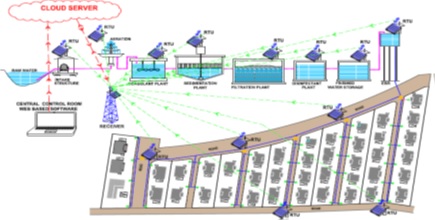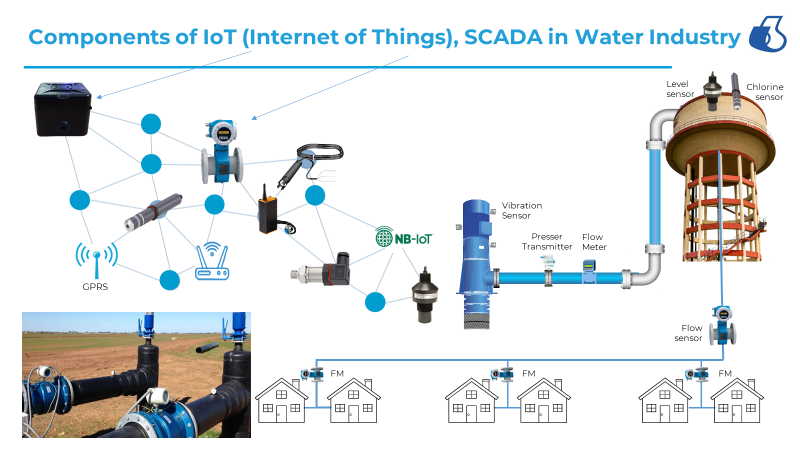Dr. Anil Kumar Mishra, Bacteriologist, Delhi Jal Board, Govt. Of Nct, Delhi
Due to urbanization, industrialization, increasing population quality and quantity of fresh water reducing drastically in India and worldwide. For fulfillment of this scarcity for water, Proper treatment and management of sewage is utmost important, which are producing form households, factories or other sources. Domestic sewage is the major source of waste water (sewage) which is composed of kitchen and bathroom waste water called “Sullage” or “Gray water” and waste water producing from toilets are known as excreta or “Black water”. Now a day, industrial waste is also mixed in our drains resulting its quality also deteriorated. Sewage treatment is also known as waste water treatment and it is one of the most important methods, adopted for better management of sewage, its recycle and disposal in environment for maintaining environmental sanitation. During treatment process in different sewage treatment Plants (STPs) or Waste water treatment plants (WWTP), reducing or removing different type of contaminants (Physical, organic, inorganic Microbiological, biological and other contaminants) present in waste water and after treatment that treated effluent may be utilized for other purpose like irrigation of crops, recharging ground water, domestic purposes other than drinking and cooking, mixing in rivers, ponds, drains or other natural water bodies without any environmental issues as per national and international guidelines. In nature, anything is not pollutant, everything is useful but if anything is present in wrong quantity, quality, place, time or nature then it is called “Pollutant”. Sewage treatment and its proper management is playing important role in environmental sanitation by managing grey water, black water, effluent treatment, solid waste management etc. Sewage may be treated into Centralized STPs (means sewage is collected from sewerage network of command area into sewage pumping station then pumped into STPs for treatment) and decentralized system (not required major SPS for pumping of sewage as treatment made through on-site small plants).In some cities, storm water also mixed into drains and ultimately reached into STPs for treatment. Population equivalence (PE) is the base value used for considering for the designing capacity of STP in any particular areas for a particular population. It is based on the per person organic matter load. One PE is equal to 60 gram of Biological Oxygen Demand (BOD) or 200 liters of sewage per day. This parameter also differentiates domestic and industrial waste. On the basis of process control and quality management in STPs, three to four stages occurs. These are:- 8 Primary treatment: In this stage suspended solids, Organic matters, oil and grease, floating materials etc. are removed up to maximum extent by physical processes like screening, grit removal, sedimentation, skimming (for removal of oil and grease from sewage) etc. 8 Secondary Treatment: In this stage remaining organic matter removed by aerobic and anaerobic biological treatment process. 8 Tertiary treatment: In this stage removing microbiological loads and other remaining organic and inorganic pollutants through filtration and proper disinfection by Chlorination, Ozonation or by any other agents or technologies. 8 Quaternary or advanced stage Treatment: In this stage, micro-pollutants such as pharmaceuticals, ingredients of domestic and industrial chemicals, pesticides, algal toxins (Blue green algae like microcystis, oscillatoria, anabaena, lyngbya etc. produce different type of toxins, which are harmful for animals).etc. are removed by using advanced filtration system or by using other advanced and sophisticated technologies. These micro-pollutants generally may not eliminate through commonly used sewage treatment processes (primary, secondary and tertiary treatment).
Purpose of Sewage treatment:
The main objective of sewage treatment is to remove different type of physical, organic, inorganic, microbiological and biological pollutants and produce final treated effluent which must be fit for intended purposes as per national and international norms /guidelines and for maintaining environmental sanitation/ hygiene. Composition of sewage water: Sewage/ Waste Water contain maximum percentage of water but due to mixing of different type of domestic and industrial waste it contains some other pollutants, which are as underneath:-
8 Water 8 Organic contaminants 8 inorganic contaminants 8 Pesticides (Aldrin, DDT, BHC, Atrazine etc.) 8 Heavy Metals (lead, cadmium, mercury etc.) 8 Pathogenic/non pathogenic bacteria, viruses, fungus, algae, protozoans, nematodes & their spores etc.) 8 Poisonous gases (H2S, CH4, CO2) etc.
Major Sewage treatment technologies: In India and worldwide many technologies are available since ancient time for proper treatment of sewage and now a days other new advanced and sophisticated technologies are establishing or arising which treats waste water up to quaternary level (depends on requirements or usability of treated effluents) . These technologies are based on biological and non-biological treatment principles (Physical, Chemical, Microbiological, Membrane filtration, Activated Charcoal/ sand filtration etc.). But all the technologies are not suitable universally for all the places and all type of waste water /sewage treatment; as its depends on quality and quantity of sewage, climatic condition, construction and operating cost, availability of land and energy, sustainability, environmental impacts (odors, vectors attraction, sludge transportation, sanitary risk, water, soil and sub-soil contaminants, surface and ground water contamination, devaluation of nearby locality etc. Most common technologies are: 8 Activated Sludge process (ASP) 8 Up flow Anaerobic sludge blanket (UASB) 8 Waste stabilization ponds (WSP) 8 Moving Bed Bio reactor (MBBR) 8 Sequential Batch Reactor (SBR) Management of Sewage/ Waste water: In India and worldwide proper sewage or waste water management is challenge and If manage it properly then may save natural resources, economical and health loss, environment, water, soil fertility etc. Properly treated effluents may utilized for different purposes, some important aspects are as underneath:
A. Supplied in household for secondary purposes like gardening, washing, etc:
Every day, we are using hundreds liter of water for our day to day activities like cooking, drinking, washing, bathing cleaning etc. but apprx. 90% of this water again reached in drains as sewage. If, we separately treat Gray (Kitchen and bathroom) water and Black water (toilet and other water) then this water may be supplied again in households for secondary purpose like washing, bathing cleaning etc.) except drinking and cooking), through separate pipelines (dual pipe supply system). This may save millions liter of treated water which may be supplied to new consumers or consumers may get round the clock water supply.
B. Recharging of underground water aquifers.:
Now a days, we are extracting much quantity of underground water for construction, irrigation, households industrial purposes etc. as compared to rate of percolation; resulting water table decreasing at the rate of 0.5- 2.0 meter per year (quality of underground water also deteriorating drastically). If, we treat waste water as per national and international standards, then this water may be utilized for recharging of aquifers through different water bodies like lakes, ponds etc; resulting quality and quantity of underground water will also improved and this water may utilized for household and other purposes when sufficient quantity of good quality of surface water will be not available.
C. Irrigation of crops, trees and other plantations:
Farmers using sewage water (untreated/partially treated) for irrigation of herbaceous vegetables, fruits, and other crops. As this water is easily available in metropolitan cities and having sufficient amount of Macronutrients (Ca, N, P, Mg, k etc.) and Micronutrients (Cu, Zn, Mo etc.) which are required for the purpose of growth of the plants but in the other side this sewage water also contains pesticides, heavy metals (Hg, Pb, As etc), bacteria, viruses, spores, and other microorganisms, organic and inorganic pollutants which are very harmful for humans, plants and other animals. As through plants food chain, these organic/inorganic contaminants reaching in our metabolic pathways and its concentration is increasing day by day in our body or in other plants and animals due to biomagnifications of pesticides and other toxic metals. The cultivation of leafy vegetables using sewage water is a common practice in various part of India and worldwide and using these vegetables with or without cooking, causing different types of health related problems. Due to various climatic factors, irregular and insufficient rain, lacking of water bodies like ponds, lake etc. for storage of rain water also playing pivotal role to encourage farmers to use treated/ partially treated/ untreated sewage as an alternative water resource for irrigation of crops in national and international level. Properly treated sewage (As per guidelines of WHO, CPCB and other national and international standards) is ideal for agriculture for irrigation purpose and is already being widely used throughout the world. Final treated effluent may also used for irrigation purpose of Parks, crops, green belts and other greenery in central and side verges of roads. This practice may save billion liters of surface as well as underground water every year; resulting we may conserve that water for other purposes.
D. Mixing into natural water bodies like ponds, river, drains etc.: In present scenario, natural water bodies like river, ponds, lake etc. have been dried or water only available during rainy season and that’s quality is also not good as per national and international standards framed for using various purposes. If after proper rejuvenation of those water bodies, we use properly treated effluent for maintaining water level of these water bodies then this water may be available for consumers, drinking purpose of cattle, birds or other animals and other purposes; as due to lack of sufficient water in those water bodies birds and other animals could not get water for drinking purpose and sometimes theirs survival also affected. These water bodied also help in reduction of gaseous and particulate environmental pollutants; as, water bodies absorb gaseous pollutant and particulate matters through evaporation and other natural process and also disperse these pollutants in natural environment in the form of modified compounds which are less harmful for environment. Some pollutants may be utilized by plants and animals living in natural water bodies for theirs metabolic activities. But at present, due to lack of these water bodies these pollutants directly reached in our environment causing air pollution (smog or other such types of problems).
E. Supplied to thermal power and other industries etc.:
In present scenario, ground or surface water is being used in thermal power, nuclear power stations or such type of other industries as a coolant or for other purposes; resulting surface or underground reducing. If we use treated effluent for this purpose then that remained water may be utilized for maintaining water table or for other purpose.
F. Treated sludge may be utilized as fertilizers in different type of crops.: In present scenario, different type of chemical fertilizers are being used for fulfillment of nutritional requirement of crops; as due to all season cropping system and repetition of same crops , fertility and productivity of land decreasing. Due to excess use of these fertilizers, pH of soil also affected and required for soil treatment by using different type of chemicals. Due to use of these chemicals soil microorganisms and other useful insects are also dying, which protect crops from different type of insects and pests and for prevention of these pests or insects, we are using different type of insecticides or pesticides resulting the concentration of these chemicals increasing in our food chain and in our metabolic activities. For avoiding these conditions, we can use properly treated sludge (by incineration or other physical, chemical and biological process) in annual, biannual and perennial crops and trees. This is economical, cheaper, environmental friendly, helpful for growth of soil mircoorganims and also maintains pH and other texture of soil as compared to chemical fertilizers.
G. Maintain environmental sanitization: Proper sewage treatment and its management also helpful for maintaining environmental sanitation and hygiene; as sewage contains different type of physical, chemical and microbiological contaminants ( bacteria, virus, fungi, protozoans, nematodes) etc. and if not managed properly then different type of water born and air born diseases may spread in community. Inadequate sanitation kills people, causes disease, environmental pollution and diminishes welfare- this is the well known but the economic impacts of the poor sanitation have not been counted properly. According to WHO study, one gram of feces may contain approx crores of viruses, lakhs of bacteria, thousands of parasitic eggs and cysts. As per USEPA, Acceptable limit of waterborne illness in a community is 01 case/10,000 consumers. Steps to be taken for proper treatment and management of Sewage: 8 STPs should be upgraded with advanced and sophisticated treatment technologies which should be sustainable, economical, environmental friendly, suitable and fulfill the purpose of treatment. 8 Quality Control laboratories should be established in all the STPs for round the clock monitoring of quality of STPs (Raw sewage till final effluent) as per national/international standards and these laboratories must be equipped with advanced and sophisticated testing technologies, equipments and qualified manpower. 8 Final treated effluent (After tertiary treatment) directly transmitted till green belt/ crop site through separate pipelines in spite of mixing in drains. Training and awareness must be provided to farmers and other users. 8 Proper guidelines and incentive policy should be framed by the Central, state or local government level for promotion of use of treated final effluent and cured sludge as manure in crops. 8 Strict guidelines may be framed by regulatory organization and must be mandatory for all the STP and other waste water treatment industries or agencies. In conclusion, sewage treatment and its proper management is a burning issue in India and worldwide. If, we properly manage sewage treatment process control, quality (as per national and international standards/ guidelines) and proper uses of treated effluent, sludge, Biogas and other byproducts of waste water treatment and solid –waste management, we can save energy, maintain environmental hygiene, reduce scarcity of water, improve quality and quantity of underground water, increasing crop production, reduce the use of chemical fertilizers, improved soil texture, improved health and life style of human and other living organisms, save money etc.





